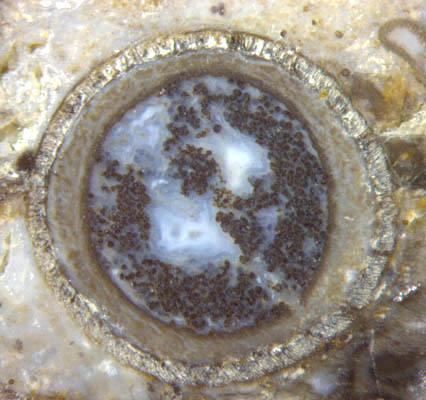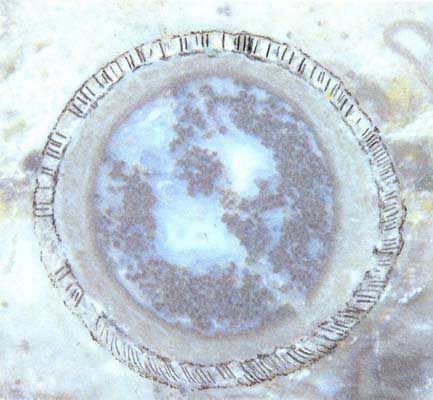Broken symmetry of Aglaophyton
sporangia
The sporangia of the Lower Devonian plant Aglaophyton,
formerly known as Rhynia major, are borne at the
end of upright stalks
and seem to be axially symmetric at first sight. Closer inspection
reveals that
the axial symmetry applies to the overall shape only. The cells of the
capsule
wall are arranged with a right-hand twist so that
the whole surface
pattern comes close to the symmetry of a screw, which becomes apparent
when the
capsule splits along a screw line (of very large pitch). The idea of
axial symmetry seems to
have
been so suggestive that the shape of the split had been
interpreted as
the result of twisting when splitting [1] but there is ample
contrary evidence. (See Rhynie
Chert News 5.)
Also there are
other Devonian plants whose capsules show an axially symmetric overall
shape but
a
twisted surface pattern.
Another
structural feature violating the
apparent axial symmetry of spore capsules is possibly a particular
feature of Aglaophyton:
It is seen on capsule cross-sections as a skew
orientation of the narrow cells of the capsule wall. Along the
circumference the
orientation may vary from radial to inclined, with inclination up to
about 45°, then back to radial again.


Figs.: Aglaophyton
sporangium cross-section with a peculiar asymmetry in the array of the
capsule
wall cells. (The cells are not so well seen on the photograph
as on the drawing after microscopic observation.)
Since the same type of asymmetry is found repeatedly and is possibly
there with every
sporangium, it is obviously not due to some growth anomaly but an
inherent feature. Apparently it has not been noticed and described
before, for several reasons: Most
sporangium sections are tilted with respect to the surface or cut face
so that the
spiral texture of the capsule wall adds another asymmetry to the
pattern. Also the array of the capsule wall cells is most often
not clearly seen all around the circumference, and the capsule wall is
often deformed, broken, or dark,
with the individual cells hardly seen.
All this may produce a confusing picture of cell orientation but
evidence
for the peculiar asymmetry described here can be found more often than
expected if one knows what to look for. It has not yet been checked
whether the skew varies with vertical position.
H.-J.
Weiss
2014
[1] David
S. Edwards, Aglaophyton
major, a non-vascular land-plant from the Devonian Rhynie
Chert,
Bot. J. Linn. Soc. 93(1986), 173-204.
 |
 |
65 |





